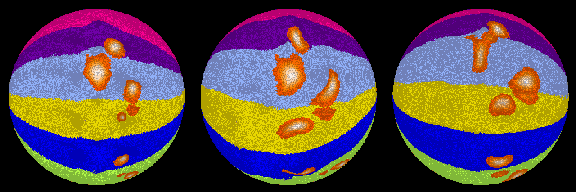NeuroImage 13, Number 6, 2001, Part 2 of 2 Parts
METHODS - ANALYSIS
Comparison of Three Cortical Flat Mapping Techniques
Using Simulated Cerebella
Monica K. Hurdal , Kelly Rehm
, Kelly Rehm
 , Kirt Schaper
, Kirt Schaper , De Witt Sumners
, De Witt Sumners , David A. Rottenberg
, David A. Rottenberg


 Department of Mathematics, Florida State University, Tallahassee, U.S.A.
Department of Mathematics, Florida State University, Tallahassee, U.S.A.
 Department of Radiology, University of Minnesota, Minneapolis, U.S.A.
Department of Radiology, University of Minnesota, Minneapolis, U.S.A.
 PET Imaging Center, VA Medical Center, Minneapolis, U.S.A.
PET Imaging Center, VA Medical Center, Minneapolis, U.S.A.
 Department of Neurology, University of Minnesota, Minneapolis, U.S.A.
Department of Neurology, University of Minnesota, Minneapolis, U.S.A.
Abstract
Since the cerebral and cerebellar cortices are topologically equivalent to a 2D sheet, surface representations of the cortex may facilitate the visualization and analysis of functional activation data by preserving important geometrical and topological relationships. Although a number of surface mapping techniques have been recently implemented and made available to the neuroscience community, in the absence of quantitative comparisons it is difficult to assess their relative advantages and disadvantages for brain mapping. Therefore, using simulated cerebella with imposed cortical activations and a series of quantitative metrics, we have begun a detailed comparison of CARET [1], CirclePack [2,3] and FreeSurfer [4].
Methods
The three flat mapping methods we are comparing are each based on a different flattening premise. CirclePack is based on mathematical theory and produces a first approximation to the conformal (angle-preserving) map. CARET adjusts forces so that linear and angular distortions are reduced during surface flattening. FreeSurfer uses geodesic distances to reduce linear and areal distortions.
To study the properties of cortical flat maps in a controlled fashion and facilitate comparisons, we created a simulated cerebellum. A surface was generated from an ellipsoidal core to which ten symmetrical "lobules" were attached. Each lobule was parameterized by its height and width at the base. Eight simulated foci of functional activation were imposed, modeling their locations after the cerebellar hommunculus of Snider [5] (Figure 1). This cortical surface was then mapped to a sphere using each of the three flattening techniques.
Results
Figure 2 illustrates the spherical flat maps obtained using the different methods. There are obvious differences in the size and extent of the activated foci. This preliminary study indicates that it is necessary to determine when each of the different cortical flattening premises are useful and exhibit advantages. We have initiated more detailed comparisons using simulated and real data to examine spatial patterns of activation, as well as the effect of anatomical and shape differences under flattening and the distortions that can occur. To this end, we have developed a detailed set of metrics to assist in quantifying different types of distortion that occur with each of the flattening methods as they apply to neuroscientific data.
References
[1] Drury, H.A., Van Essen, D.C., et al. 1996. J. Cogn. Neurosci. 8:1-28. CARET is available from http://stp.wustl.edu
[2] Hurdal, M.K., Bowers, P.L., et al. 1999. In Lecture Notes in Computer Science (C. Taylor, and A. Colchester, Eds.), Springer, Berlin, 1679:279-286. CirclePack is available from http://pet.med.va.gov:8080/incweb
[3] Hurdal, M.K., Stephenson, K., et al. Submitted to NeuroImage.
[4] Fischl, B., Sereno, M.I., et al. 1999. NeuroImage 9:179-194. FreeSurfer is available from http://surfer.nmr.mgh.harvard.edu
[5] Snider, R.S. 1952. Res. Publ. Assoc. Res. Nerv. Dis. 30:267-281.
Acknowledgements
This work was supported in part by NIH Human Brain Project grant MH57180. The authors would also like to acknowledge Ken Stephenson, Department of Mathematics, University of Tennessee, Knoxville; Phil Bowers, Department of Mathematics, Florida State University; Josh Stern, VA Medical Center, Minneapolis.

Figure 1: Simulated cerebellar surface. Surface was colored according to different lobes and simulated foci of functional activation were imposed on the surface.|

Figure 2: Spherical maps produced by different methods. Left: CirclePack; center: CARET; right: FreeSurfer. Note the shape and size differences in the foci of functional activation across methods.|
S157
 , Kelly Rehm
, Kelly Rehm
 , Kirt Schaper
, Kirt Schaper , De Witt Sumners
, De Witt Sumners , David A. Rottenberg
, David A. Rottenberg


 Department of Mathematics, Florida State University, Tallahassee, U.S.A.
Department of Mathematics, Florida State University, Tallahassee, U.S.A. Department of Radiology, University of Minnesota, Minneapolis, U.S.A.
Department of Radiology, University of Minnesota, Minneapolis, U.S.A. PET Imaging Center, VA Medical Center, Minneapolis, U.S.A.
PET Imaging Center, VA Medical Center, Minneapolis, U.S.A. Department of Neurology, University of Minnesota, Minneapolis, U.S.A.
Department of Neurology, University of Minnesota, Minneapolis, U.S.A.
